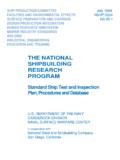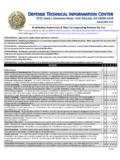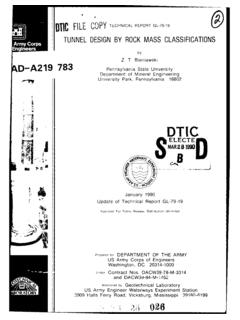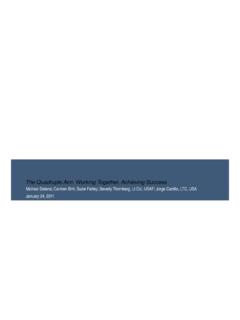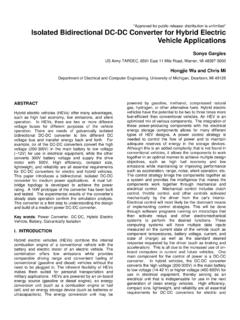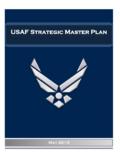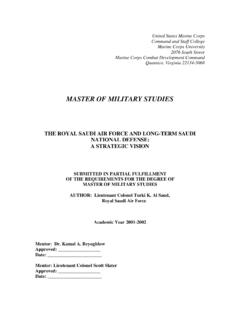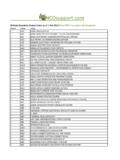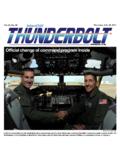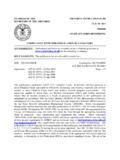Transcription of AIR FORCE INSTITUTE OF TECHNOLOGY
1 `. , Single-Author Thesis THE EFFECT OF SUPPLY CHAIN. MANAGEMENT PROCESSES ON. COMPETITIVE ADVANTAGE AND. ORGANIZATIONAL PERFORMANCE. THESIS. Ronald M. Salazar, SMSgt, usaf . AFIT-LSCM-ENS-12-16. DEPARTMENT OF THE AIR FORCE . AIR UNIVERSITY. AIR FORCE INSTITUTE OF TECHNOLOGY . Wright-Patterson Air FORCE Base, Ohio DISTRIBUTION STATEMENT A: APPROVED FOR PUBLIC RELEASE; DISTRIBUTION UNLIMITED. Sample 3. Disclaimer Statement The views expressed in this thesis are those of the author and do not reflect the official policy or position of the United States Air FORCE , Department of Defense, or the United States Government. AFIT-LSCM-ENS-12-16. THE EFFECT OF SUPPLY CHAIN MANAGEMENT PROCESSES ON. COMPETITIVE ADVANTAGE AND ORGANIZATIONAL PERFORMANCE. THESIS. Presented to the Faculty Department of Systems and Engineering Management Graduate School of Engineering and Management Air FORCE INSTITUTE of TECHNOLOGY Air University Air Education and Training Command In Partial Fulfillment of the Requirements for the Degree of Master of Science in Engineering and Environmental Management Ronald M.
2 Salazar, BS. SMSgt, usaf . March 2012. DISTRIBUTION STATEMENT A: APPROVED FOR PUBLIC RELEASE; DISTRIBUTION UNLIMITED. Sample 4. Thesis Title Page, Single Author AFIT-LSCM-ENS-12-16. THE EFFECT OF SUPPLY CHAIN MANAGEMENT PROCESSES ON. COMPETITIVE ADVANTAGE AND ORGANIZATIONAL PERFORMANCE. Ronald M. Salazar, BS. SMSgt, usaf . Approved: _____//signed//_____ 15 March 2012. William Cunningham (Chairman) Date _____//signed//_____ 15 March 2012. Sharon G. Heilmann, Lt Col, usaf (Member) Date _____//signed//_____ 15 March 2012. Daniel D. Mattioda, Maj, usaf (Member) Date Sample 7. MS Thesis Approval Page AFIT-LSCM-ENS-12-16. Abstract One of the most significant changes in the paradigm of modern business management is that individual businesses no longer compete as solely autonomous entities, but rather as supply chains. In this emerging competitive environment, the ultimate success of the business will depend on management's ability to integrate the company's intricate network of business relationships.
3 Effective supply chain management (SCM) has become a potentially valuable way of securing competitive advantage and improving organizational performance since competition is no longer between organizations, but among supply chains. This research conceptualizes and develops three dimensions of SCM practice (supplier relationship management, manufacturing flow management, and product development and commercialization) and tests the relationships between these SCM practices, competitive advantage, and organizational performance. Data for the study was collected from prominent organizations and the relationships proposed in the framework were tested using rigorous statistical techniques. The results indicate that higher levels of SCM practice can lead to enhanced competitive advantage and improved organizational performance. These results have value to both the academic and business worlds as they provide verification of the widely held belief of the value of effective supply chain management.
4 Iv Sample 9. Acknowledgments I would like to express my sincere appreciation to my faculty advisor, Dr. William Cunningham, for his guidance and support throughout the course of this thesis effort. I would also like to thank my committee members, Lt Col Sharon Heilmann &. Maj Daniel Mattioda. The success of this research effort was made possible by the work and dedication of each of the members of the research team. Most importantly, I would like to express my love and appreciation to my wife for taking care of things on the home front, and my daughter for all she did to support me in this endeavor. Their encouragement ultimately led to my graduation. I could not have done it without them. Ronald M. Salazar Sample 11. Acknowledgments v Table of Contents Page Abstract .. iv Acknowledgements ..v Table of Contents .. vi List of Figures .. viii List of Tables .. ix I. Introduction ..1. II. Literature Review ..5. Supply chain management ..5. Supplier relationship management.
5 8. Manufacturing flow management ..20. Product development and commercialization ..34. Competitive advantage ..45. Organizational performance ..47. III. Methodology ..51. Procedures ..51. Participants ..52. Measures ..56. IV. Results and Analysis ..65. Data ..65. Hypothesis one ..65. Hypothesis two ..66. Hypothesis three ..66. Hypothesis four ..66. Hypothesis five ..67. Hypothesis six ..67. V. Future Research ..72. Conclusion ..73. Appendix A. Supply Chain Management Survey Cover Appendix B. Supply Chain Management Survey ..75. vi Appendix C. Story Board ..88. Bibliography ..90. Vita ..100. Sample 12. Table of Contents (continued). vii List of Figures Figure Page 1. Eight supply chain management processes ..2. 2. Research model ..4. 3. Supplier relationship management ..10. 4. Strategic supplier relationship management sub-processes ..11. 5. Operational supplier relationship management sub-processes ..13. 6. Manufacturing flow management sub-processes ..23. 7. Strategic manufacturing flow management sub-processes.
6 24. 8. Operational manufacturing flow management sub-processes ..28. 9. Product development and commercialization sub-processes ..36. 10. Strategic product development and commercialization sub-processes ..37. 11. Operational product development and commercialization sub-processes ..39. Sample 13. List of Figures viii List of Tables Table Page 1. Supply chain management definitions ..6. 2. Types of flexibility ..32. 3 Comparison of Perspectives: Marketing, Organizations, Engineering, and Operations Mgmt..42. 4. Company Profile ..55. 5. Number of Employees ..55. 6. Annual Volume of Sales ..55. 7. Industry Classification ..56. 8. Variable Descriptive Statistics (Response Data Sample) ..57. 9. Variable Descriptive Statistics (Generated Data Sample) ..57. 10. CFA Component Matrix ..59. 11. Pearson Correlation Coefficient Summary (Original data) ..68. 12. Pearson Correlation Coefficient Summary (Generated data) ..69. Sample 14. List of Tables ix EFFECT OF SUPPLY CHAIN MANAGEMENT PROCESSES ON COMPETITIVE.
7 ADVANTAGE AND ORGANIZATIONAL PERFORMANCE. I. Introduction The goal of Supply Chain Management (SCM) is to integrate both information and material flows seamlessly across the supply chain as an effective competitive weapon (Childhouse, 2003) The name is somewhat misleading as a supply chain is not a formal chain of businesses, but a network of businesses and relationships. In reviewing the prevailing literature available, it is clear that one common definition of SCM does not exist. The Global Supply Chain Forum consists of top executives of leading firms from a wide variety of industries, such as communications and TECHNOLOGY , consumer packaged goods, fashion apparel, commodity merchandising, oil and petrochemicals, automotive manufacturing, athletic equipment, household plumbing and accessories, and consumer electronics. Member companies represent all possible locations across a supply chain: original suppliers, manufacturers of industrial products (business to business), manufacturers of consumer products, distributors, and retailers.
8 Therefore, the views presented by the Global Supply Chain Forum represents combined knowledge and experiences from leading firms in the corresponding industry (Goldsby, et al, 2003). The members of the Global Supply Chain Forum (2009) have developed the following definition which neatly encapsulates the aspects of SCM: Supply chain management is the integration of key business processes from end-user through original suppliers that provides products, services, and information that add value for customers and other stakeholders. This view of SCM is illustrated in Figure 1(Drucker, 1998), which depicts a simplified supply chain network structure, the information and product 1. flows, and the SCM processes that integrate functions within the company as well as other firms across the supply chain. The eight supply chain management processes identified by the Global Supply Chain Forum and shown in Figure 1 are: Figure 1. Eight supply chain management processes (Lambert, 2008).
9 Customer relationship management provides the firm's face to the customer, including management of the PSAs, and provides a single source of customer information. Supplier relationship management provides the structure for how relationships with suppliers are developed and maintained, including the establishment of PSAs between the firm and its suppliers. Customer service management- provides the firm's face to the customer, including management of the PSAs, and provides a single source of customer information 2. Demand management- provides the structure for balancing the customers'. requirements with the capabilities of the supply chain. Order fulfillment- includes all activities necessary to define customer requirements, design the logistics network, and fill customer orders. Manufacturing flow management- includes all activities necessary to move products through the plants and to obtain, implement, and manage manufacturing flexibility in the supply chain. Product development and commercialization provides the structure for developing and bringing to market new products jointly with customers and suppliers.
10 Returns management- includes all activities related to returns, reverse logistics, gatekeeping, and avoidance. Each SCM process has both strategic and operational sub-processes. The strategic sub-processes provide the structure for how the process will be implemented and the operational sub-processes provide the detailed steps for implementation. The strategic process is a necessary step in integrating the firm with other members of the supply chain, and it is at the operational level that the day-to-day activities take place (Lambert, 2008). This survey instrument utilized in this study aims at filling the gap in the literature on the effect of supply chain processes by empirically testing the effect of the eight processes on organizational performance and competitive advantage. However, due to size limitations and time constraints, only three of the processes and their effect on organizational performance and competitive advantage are fully examined in this study: supplier relationship management, manufacturing flow management, and 3.


